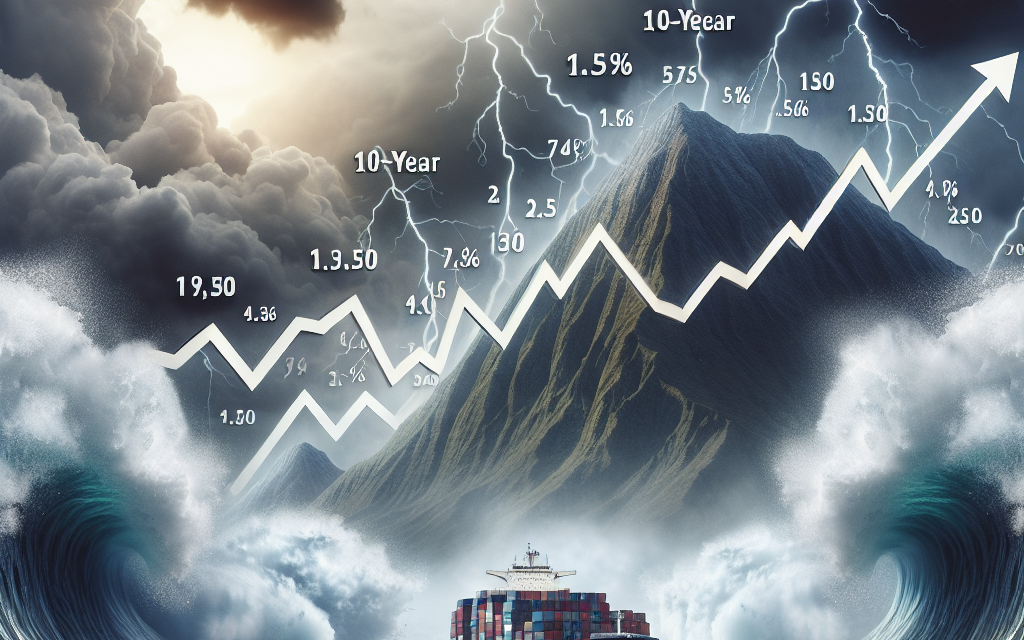“Rising 10-Year Treasury Yields Spark Market Jitters: Morning Update”
Introduction
Rising 10-year Treasury yields have become a focal point of concern for investors, signaling potential shifts in economic conditions and monetary policy. As yields climb, market participants are grappling with implications for borrowing costs, equity valuations, and overall economic growth. This morning update delves into the latest movements in Treasury yields, their impact on various asset classes, and the broader market sentiment as investors navigate this evolving landscape.
Impact of Rising Treasury Yields on Stock Markets
The recent surge in 10-year Treasury yields has sparked considerable anxiety across financial markets, prompting investors to reassess their strategies and expectations. As yields rise, the implications for stock markets become increasingly pronounced, influencing both investor sentiment and market dynamics. Higher Treasury yields typically signal a shift in the economic landscape, often reflecting expectations of increased inflation or tighter monetary policy. Consequently, this shift can lead to a reevaluation of risk assets, particularly equities.
When Treasury yields climb, the cost of borrowing increases, which can dampen corporate profits. Companies often rely on debt to finance expansion, and higher interest rates can lead to increased expenses, thereby squeezing margins. This scenario is particularly concerning for growth-oriented sectors, such as technology, where valuations are heavily dependent on future earnings. As yields rise, the present value of those future earnings diminishes, leading to a potential recalibration of stock prices. Investors may begin to favor value stocks, which tend to be less sensitive to interest rate fluctuations, over growth stocks, resulting in a sector rotation that can further exacerbate market volatility.
Moreover, rising Treasury yields can also impact investor behavior. As fixed-income investments become more attractive relative to equities, some investors may choose to shift their portfolios away from stocks and into bonds. This shift can lead to increased selling pressure in the stock market, contributing to downward price movements. Additionally, the psychological impact of rising yields cannot be understated; as investors perceive higher yields as a signal of potential economic instability, fear and uncertainty can lead to more pronounced market reactions.
The relationship between Treasury yields and stock prices is further complicated by the broader economic context. For instance, if rising yields are driven by strong economic growth, the impact on equities may be less severe, as robust economic conditions can support corporate earnings. Conversely, if yields are rising due to inflationary pressures or concerns about the Federal Reserve’s tightening monetary policy, the outlook for stocks may become more precarious. In such scenarios, investors may brace for a potential slowdown in economic activity, prompting a more cautious approach to equity investments.
In addition to these dynamics, the global context also plays a crucial role in shaping market reactions to rising Treasury yields. As the U.S. economy remains a focal point for global investors, shifts in U.S. interest rates can have ripple effects across international markets. For example, if U.S. yields rise significantly, capital may flow out of emerging markets as investors seek higher returns domestically. This capital flight can lead to currency depreciation and increased volatility in those markets, further complicating the global investment landscape.
In conclusion, the rising 10-year Treasury yields are stirring anxiety in stock markets, prompting a reevaluation of investment strategies and risk assessments. The interplay between higher yields, corporate profitability, and investor behavior creates a complex environment that can lead to increased volatility and sector rotation. As investors navigate this landscape, the broader economic context and global implications of rising yields will remain critical factors influencing market dynamics. Ultimately, the ability to adapt to these changes will be essential for investors seeking to mitigate risks and capitalize on emerging opportunities in an evolving financial landscape.
Historical Trends of 10-Year Treasury Yields
The 10-year Treasury yield has long been a critical indicator of economic health and investor sentiment, serving as a benchmark for various interest rates across the financial landscape. Historically, these yields have exhibited significant fluctuations, influenced by a myriad of factors including inflation expectations, Federal Reserve policies, and broader economic conditions. As we delve into the historical trends of 10-year Treasury yields, it becomes evident that their movements are often reflective of the prevailing economic climate and investor behavior.
In the aftermath of the 2008 financial crisis, for instance, the 10-year Treasury yield plummeted to unprecedented lows, reaching around 1.4% in 2012. This decline was largely a result of the Federal Reserve’s aggressive monetary policy, which included quantitative easing measures aimed at stimulating the economy. During this period, investors flocked to the safety of government bonds, driving yields down as prices rose. The low yield environment persisted for several years, as economic recovery remained sluggish and inflation remained subdued.
However, as the economy began to show signs of strength in the mid-2010s, the 10-year Treasury yield started to rise, reflecting growing confidence among investors. By late 2016, yields had climbed to over 2.5%, driven by expectations of fiscal stimulus and potential interest rate hikes under the incoming administration. This upward trajectory continued into 2018, when yields reached a peak of approximately 3.2%. The increase was fueled by a robust labor market, rising consumer spending, and a tightening monetary policy, which collectively contributed to heightened inflation expectations.
Yet, the trend was not linear. In 2019, the yield experienced a sharp decline, falling below 2% as concerns over a potential economic slowdown and trade tensions between the United States and China weighed heavily on investor sentiment. This volatility underscored the sensitivity of Treasury yields to geopolitical events and economic indicators, as investors sought refuge in safe-haven assets amid uncertainty.
As we moved into 2020, the onset of the COVID-19 pandemic brought about a dramatic shift in the economic landscape. In response to the crisis, the Federal Reserve slashed interest rates to near-zero levels and resumed quantitative easing, which once again pushed the 10-year Treasury yield to historic lows. By August 2020, yields had fallen to around 0.5%, reflecting the pervasive uncertainty and the urgent need for economic support.
However, as the economy began to recover in 2021, fueled by vaccination efforts and fiscal stimulus, the 10-year Treasury yield began to rise once more. By early 2022, yields had surged past 1.7%, driven by concerns over inflation and the potential for the Federal Reserve to tighten monetary policy sooner than anticipated. This resurgence in yields highlighted the delicate balance between economic recovery and inflationary pressures, as investors recalibrated their expectations in light of changing economic conditions.
In recent months, the trend has continued to evolve, with rising yields stirring anxiety in the markets. As investors grapple with the implications of higher borrowing costs and potential impacts on economic growth, the historical context of 10-year Treasury yields serves as a reminder of their pivotal role in shaping market dynamics. Understanding these trends not only provides insight into past economic cycles but also equips investors with the knowledge to navigate the complexities of the current financial landscape. As we look ahead, the trajectory of 10-year Treasury yields will undoubtedly remain a focal point for market participants, reflecting the ongoing interplay between economic fundamentals and investor sentiment.
Investor Sentiment Amidst Increasing Yields
As the financial markets navigate the complexities of an evolving economic landscape, rising 10-year Treasury yields have become a focal point of investor sentiment. The recent uptick in these yields, which are often viewed as a benchmark for long-term interest rates, has sparked a wave of anxiety among market participants. This anxiety is primarily rooted in the implications that higher yields may have on borrowing costs, consumer spending, and overall economic growth. Consequently, investors are closely monitoring these developments, as they could signal shifts in monetary policy and broader market dynamics.
The increase in 10-year Treasury yields can be attributed to several factors, including expectations of tighter monetary policy from the Federal Reserve. As inflationary pressures persist, the central bank may be compelled to raise interest rates more aggressively than previously anticipated. This potential shift in policy has led to a recalibration of investor expectations, resulting in a sell-off of bonds and a corresponding rise in yields. As yields climb, the attractiveness of fixed-income investments diminishes, prompting investors to reassess their portfolios and consider reallocating assets to equities or other asset classes.
Moreover, the rising yields have implications for the housing market, as higher mortgage rates can dampen demand for home purchases. This scenario creates a ripple effect throughout the economy, as reduced housing activity can lead to slower growth in related sectors, such as construction and home improvement. Consequently, investors are increasingly concerned about the potential for a slowdown in economic momentum, which could impact corporate earnings and, by extension, stock market performance. The interplay between rising yields and economic growth is a delicate balance that investors must navigate carefully.
In addition to these macroeconomic considerations, investor sentiment is also influenced by geopolitical factors and global economic conditions. For instance, uncertainties surrounding international trade, supply chain disruptions, and geopolitical tensions can exacerbate market volatility. As investors grapple with these multifaceted challenges, the rising 10-year Treasury yields serve as a barometer for broader market sentiment. A significant increase in yields may signal a shift in risk appetite, prompting investors to adopt a more cautious stance.
Furthermore, the psychological aspect of rising yields cannot be overlooked. As yields increase, they may trigger fears of an impending recession, leading to a flight to safety among investors. This behavior can manifest in increased demand for gold, cash, and other safe-haven assets, further complicating the investment landscape. The interplay between fear and opportunity creates a challenging environment for investors, who must weigh the potential for higher returns against the risks associated with rising yields.
In conclusion, the rising 10-year Treasury yields are stirring a complex mix of anxiety and recalibration among investors. As they navigate the implications of these increases on borrowing costs, economic growth, and market dynamics, it is essential for market participants to remain vigilant and informed. The evolving landscape necessitates a nuanced understanding of both macroeconomic indicators and investor psychology. Ultimately, how investors respond to these rising yields will shape the trajectory of the markets in the coming months, underscoring the importance of adaptability and strategic foresight in an ever-changing financial environment.
Federal Reserve’s Role in Treasury Yield Fluctuations
The fluctuations in 10-year Treasury yields have become a focal point of concern for investors and market analysts alike, particularly as these movements are often influenced by the actions and policies of the Federal Reserve. As the central bank of the United States, the Federal Reserve plays a pivotal role in shaping economic conditions, and its decisions regarding interest rates can have profound implications for Treasury yields. When the Fed signals a potential increase in interest rates, it typically leads to a rise in Treasury yields, as investors adjust their expectations for future returns. This relationship is crucial to understanding the current market dynamics.
In recent months, the Federal Reserve has adopted a more hawkish stance, primarily in response to persistent inflationary pressures. As inflation remains above the Fed’s target, the central bank has indicated its willingness to raise interest rates further to stabilize prices. This shift in policy has contributed to an uptick in 10-year Treasury yields, which are often viewed as a benchmark for long-term borrowing costs. Consequently, as yields rise, the cost of financing for consumers and businesses also increases, which can dampen economic growth and consumer spending.
Moreover, the Fed’s actions are closely monitored by investors, who often react swiftly to any hints of policy changes. For instance, when the Fed releases its meeting minutes or provides forward guidance on interest rates, market participants analyze these communications for clues about the future trajectory of monetary policy. If the Fed suggests that it may continue to raise rates, investors may anticipate higher yields on Treasuries, leading to a sell-off in the bond market. This sell-off can create a feedback loop, where rising yields further exacerbate market anxiety, prompting additional volatility.
In addition to interest rate decisions, the Federal Reserve’s balance sheet management also plays a significant role in influencing Treasury yields. The central bank’s quantitative easing programs, which involve purchasing large quantities of government securities, have historically kept yields low by increasing demand for Treasuries. However, as the Fed begins to unwind these programs and reduce its balance sheet, the supply of Treasuries in the market increases, which can lead to upward pressure on yields. This transition from a period of accommodative monetary policy to a more restrictive environment can create uncertainty among investors, as they grapple with the implications of reduced liquidity in the bond market.
Furthermore, global economic conditions and geopolitical events can also impact Treasury yields, often in conjunction with the Fed’s policies. For example, if economic data from other major economies suggests a slowdown, investors may flock to U.S. Treasuries as a safe haven, driving yields down. Conversely, if the global outlook appears robust, investors may seek higher returns elsewhere, leading to a sell-off in Treasuries and rising yields. Thus, the interplay between the Federal Reserve’s actions and broader market dynamics creates a complex landscape for Treasury yields.
In conclusion, the Federal Reserve’s role in Treasury yield fluctuations is multifaceted and significant. As the central bank navigates the challenges of inflation and economic growth, its decisions regarding interest rates and balance sheet management will continue to shape market expectations and investor behavior. As rising 10-year Treasury yields stir anxiety in the markets, understanding the underlying factors at play, particularly the influence of the Federal Reserve, becomes essential for navigating this evolving financial landscape.
Sector-Specific Reactions to Higher Yields
As the financial landscape continues to evolve, the recent surge in 10-year Treasury yields has elicited a range of reactions across various sectors of the economy. This increase, which reflects growing investor concerns about inflation and potential shifts in monetary policy, has significant implications for different industries. Understanding these sector-specific responses is crucial for investors and analysts alike, as they navigate the complexities of a changing market environment.
In the technology sector, higher Treasury yields have sparked anxiety among investors, primarily due to the sector’s reliance on low borrowing costs for growth and innovation. As yields rise, the cost of capital increases, which can dampen the appetite for investment in new projects and expansion. Consequently, technology stocks, particularly those with high valuations based on future earnings, have experienced heightened volatility. Investors are reassessing their positions, leading to a sell-off in growth-oriented tech companies, as the prospect of higher interest rates diminishes the present value of their anticipated cash flows.
Conversely, the financial sector has generally responded positively to the uptick in Treasury yields. Banks and financial institutions often benefit from a steeper yield curve, which allows them to borrow at lower short-term rates while lending at higher long-term rates. This environment can enhance profit margins, making financial stocks more attractive to investors. As a result, many banks have reported increased optimism regarding their earnings outlook, with analysts projecting stronger performance in the coming quarters. This divergence in sentiment between technology and financial stocks underscores the broader implications of rising yields on sector performance.
Meanwhile, the real estate sector faces its own set of challenges in the wake of higher Treasury yields. Rising yields typically lead to increased mortgage rates, which can dampen housing demand and slow down the pace of home sales. As potential buyers grapple with higher borrowing costs, the affordability of homes becomes a pressing concern. Real estate investment trusts (REITs) may also feel the pinch, as higher interest rates can lead to increased financing costs and reduced property valuations. Consequently, investors in this sector are closely monitoring yield movements, as they can significantly impact both residential and commercial real estate markets.
In the consumer discretionary sector, the response to rising yields has been mixed. On one hand, higher interest rates can lead to reduced consumer spending, as individuals may prioritize debt repayment over discretionary purchases. This shift can adversely affect companies that rely heavily on consumer spending, particularly in sectors such as retail and leisure. On the other hand, some companies within this sector may benefit from a strong labor market and rising wages, which could offset the negative impacts of higher borrowing costs. Thus, the overall effect of rising yields on consumer discretionary stocks remains nuanced, with varying implications for different companies.
Lastly, the energy sector has also felt the impact of rising Treasury yields, albeit in a more complex manner. Higher yields can signal expectations of stronger economic growth, which may boost demand for energy. However, the sector is also sensitive to changes in interest rates, as increased borrowing costs can affect capital expenditures for exploration and production. As a result, energy companies are navigating a delicate balance between potential demand growth and the challenges posed by rising financing costs.
In summary, the rise in 10-year Treasury yields has triggered a spectrum of reactions across various sectors, each grappling with its unique challenges and opportunities. As investors continue to assess the implications of these changes, understanding the sector-specific dynamics will be essential for making informed decisions in an increasingly complex market environment.
Global Economic Implications of U.S. Treasury Yields
The recent surge in 10-year U.S. Treasury yields has sparked considerable anxiety across global markets, prompting investors to reassess their strategies in light of potential economic implications. As these yields rise, they signal a shift in investor sentiment, reflecting concerns about inflation, interest rates, and overall economic stability. This development is particularly significant given the interconnectedness of global financial systems, where changes in U.S. Treasury yields can reverberate far beyond American borders.
To begin with, rising Treasury yields typically indicate that investors expect higher inflation in the future. When yields increase, it often suggests that the market anticipates the Federal Reserve will raise interest rates to combat inflationary pressures. Consequently, this expectation can lead to a tightening of financial conditions, which may slow economic growth. As borrowing costs rise, both consumers and businesses may become more cautious in their spending, potentially leading to a slowdown in economic activity. This scenario is particularly concerning for emerging markets, which often rely on U.S. capital inflows. Higher yields can result in capital flight, as investors seek better returns elsewhere, thereby destabilizing these economies.
Moreover, the implications of rising Treasury yields extend to the foreign exchange markets. As U.S. yields climb, the dollar often strengthens against other currencies, making U.S. exports more expensive and imports cheaper. This dynamic can exacerbate trade imbalances and put pressure on countries with weaker currencies, leading to inflationary pressures in those economies. For instance, nations that import a significant amount of goods may find their costs rising, which could lead to increased prices for consumers and potentially stifle economic growth.
In addition to these immediate effects, the rise in Treasury yields can also influence global equity markets. Higher yields typically lead to increased discount rates for future cash flows, which can negatively impact stock valuations. As investors reassess the risk-reward balance, sectors that are sensitive to interest rates, such as technology and real estate, may experience heightened volatility. This shift in sentiment can create a ripple effect, as declining stock prices may lead to reduced consumer confidence and spending, further dampening economic prospects.
Furthermore, the geopolitical landscape is also affected by fluctuations in U.S. Treasury yields. Countries that hold significant amounts of U.S. debt may find their financial strategies challenged as yields rise. For instance, nations like China and Japan, which are major holders of U.S. Treasuries, could face increased pressure on their own economies if they decide to adjust their holdings in response to rising yields. This could lead to a reevaluation of their foreign exchange policies and impact global trade dynamics.
In conclusion, the rising 10-year Treasury yields are not merely a domestic concern; they carry profound implications for the global economy. As investors navigate this shifting landscape, the potential for increased inflation, changes in capital flows, and volatility in equity markets looms large. The interconnected nature of today’s financial systems means that developments in the U.S. can have far-reaching consequences, affecting everything from consumer spending to international trade. As market participants remain vigilant, the unfolding situation will require careful monitoring to gauge its impact on both the U.S. economy and the broader global financial landscape.
Strategies for Investors in a High-Yield Environment
As the financial landscape continues to evolve, the recent surge in 10-year Treasury yields has prompted a wave of anxiety among investors. This increase, driven by a combination of factors including inflationary pressures and shifts in monetary policy, has significant implications for investment strategies. In this high-yield environment, investors must adapt their approaches to navigate the complexities of the market effectively.
To begin with, it is essential for investors to reassess their fixed-income allocations. Traditionally, Treasury bonds have been viewed as a safe haven, providing stability and predictable returns. However, as yields rise, the attractiveness of these instruments diminishes, leading to potential capital losses for those holding existing bonds. Consequently, investors may want to consider diversifying their fixed-income portfolios by incorporating shorter-duration bonds or floating-rate securities. These alternatives can help mitigate interest rate risk while still providing exposure to the bond market.
Moreover, equities may present a more appealing opportunity in a high-yield environment. As Treasury yields climb, the cost of borrowing increases, which can impact corporate profits and valuations. Nevertheless, certain sectors may benefit from this shift. For instance, financial institutions often thrive in rising interest rate environments, as they can charge more for loans while maintaining lower rates on deposits. Therefore, investors should evaluate sector-specific opportunities, focusing on those that are likely to outperform in a higher yield context.
In addition to sector rotation, investors should also consider the potential for value investing. As growth stocks have dominated the market in recent years, rising yields may prompt a reevaluation of these high-flying equities. Value stocks, which are typically characterized by lower price-to-earnings ratios and stable dividends, may become more attractive as investors seek out companies that can provide solid returns without the volatility associated with growth stocks. By identifying undervalued companies with strong fundamentals, investors can position themselves to benefit from a market correction that favors value over growth.
Furthermore, it is crucial for investors to remain vigilant regarding inflation. Rising yields often signal concerns about inflation, which can erode purchasing power and impact overall economic growth. In this context, commodities and real assets may serve as effective hedges against inflation. By allocating a portion of their portfolios to assets such as gold, real estate, or infrastructure, investors can protect their wealth from the adverse effects of rising prices.
Lastly, maintaining a disciplined approach to asset allocation is vital in a high-yield environment. Investors should regularly review their portfolios to ensure they align with their risk tolerance and investment objectives. This may involve rebalancing to maintain desired exposure to various asset classes or adjusting strategies in response to changing market conditions. By staying informed and proactive, investors can navigate the challenges posed by rising Treasury yields while positioning themselves for long-term success.
In conclusion, the current landscape of rising 10-year Treasury yields necessitates a thoughtful reassessment of investment strategies. By diversifying fixed-income holdings, exploring sector-specific opportunities, embracing value investing, considering inflation hedges, and maintaining disciplined asset allocation, investors can effectively manage the risks associated with a high-yield environment. As the market continues to evolve, those who remain adaptable and informed will be better equipped to seize opportunities and mitigate potential pitfalls.
Q&A
1. **What are 10-Year Treasury Yields?**
– 10-Year Treasury Yields are the interest rates on U.S. government bonds that mature in ten years, reflecting investor expectations about future economic conditions and inflation.
2. **Why are rising yields causing market anxiety?**
– Rising yields can indicate higher borrowing costs, which may slow economic growth and impact corporate profits, leading to concerns among investors.
3. **What factors contribute to the increase in 10-Year Treasury Yields?**
– Factors include expectations of higher inflation, changes in Federal Reserve monetary policy, and increased government borrowing.
4. **How do rising yields affect stock markets?**
– Higher yields can lead to lower stock prices as investors may shift their money from equities to bonds, seeking safer returns.
5. **What sectors are most impacted by rising Treasury yields?**
– Interest-sensitive sectors like real estate, utilities, and consumer discretionary are typically most affected by rising yields.
6. **What is the Federal Reserve’s role in influencing Treasury yields?**
– The Federal Reserve sets short-term interest rates and conducts monetary policy, which can influence investor expectations and, consequently, long-term Treasury yields.
7. **What should investors consider during periods of rising yields?**
– Investors should assess their risk tolerance, consider diversifying their portfolios, and stay informed about economic indicators and Federal Reserve actions.
Conclusion
Rising 10-year Treasury yields are contributing to increased market anxiety as investors react to potential implications for borrowing costs, economic growth, and inflation. This uptick in yields may lead to volatility in equity markets, as higher interest rates can dampen consumer spending and corporate investment. Overall, the market is closely monitoring these developments, as sustained increases in yields could signal shifts in monetary policy and economic outlook.





